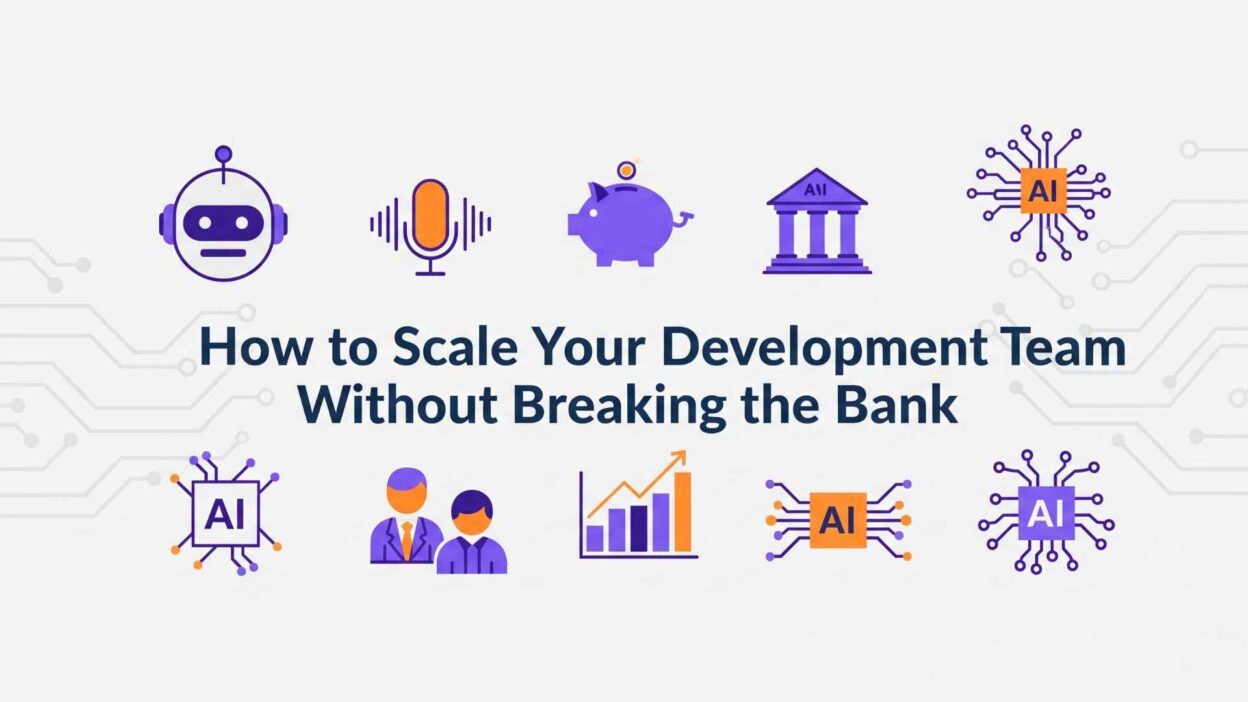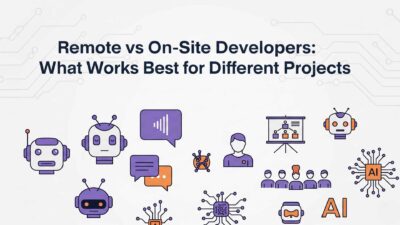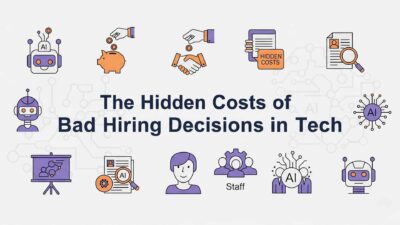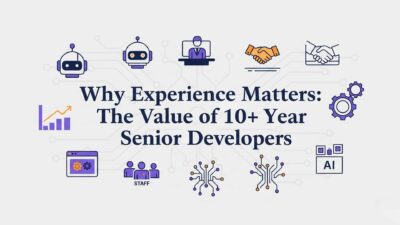TL;DR:
Scaling a development team cost-effectively requires strategic hiring, leveraging offshore talent, implementing automation tools, and optimizing team structures. Companies can reduce hiring costs by 40-60% while maintaining quality through smart outsourcing, remote-first strategies, and AI-powered development tools. Focus on building scalable processes, investing in junior talent development, and creating efficient workflows that grow with your team.
The challenge of scaling a development team while maintaining budget constraints is one of the most critical decisions facing growing companies today. With the average software engineer salary reaching $120,000+ in major tech hubs and recruitment costs soaring to 20-30% of annual salaries, traditional scaling approaches can quickly drain resources. However, innovative companies are discovering cost-effective strategies that allow them to scale development teams by 200-300% while keeping costs manageable.
Table of Contents
The Real Cost of Traditional Team Scaling
Before diving into cost-effective solutions, it’s essential to understand why traditional scaling approaches are financially unsustainable for most growing companies.
Hidden Costs of In-House Scaling:
- Base salaries: $80k-$180k per developer depending on location and seniority
- Benefits and overhead: Additional 25-40% on top of base salary
- Recruitment costs: $15k-$25k per successful hire
- Onboarding time: 3-6 months to reach full productivity
- Office space and equipment: $2k-$5k per employee annually
- Training and development: $3k-$8k per employee per year
A typical 5-person development team expansion can easily cost $500k-$800k annually when factoring in all associated expenses. For startups and SMEs, this represents a significant financial commitment that may not align with revenue growth timelines.
Strategy 1: Smart Geographic Arbitrage
Leveraging Global Talent Pools
One of the most effective ways to scale your development team cost-effectively is through strategic geographic arbitrage. This doesn’t mean compromising on quality – it means accessing world-class talent in markets with more favorable cost structures.
High-ROI Regions for Development Talent:
- Eastern Europe: Poland, Ukraine, Romania (60-70% cost savings)
- Latin America: Argentina, Colombia, Mexico (50-65% cost savings)
- Southeast Asia: Philippines, Vietnam, Malaysia (65-75% cost savings)
- India: Tier-2 cities like Pune, Chennai, Hyderabad (70-80% cost savings)
Implementation Framework:
- Start with 1-2 remote developers to test processes and communication flows
- Establish clear communication protocols including overlap hours and daily standups
- Invest in collaboration tools like Slack, Zoom, and project management platforms
- Create detailed documentation for all processes and coding standards
- Scale gradually adding 2-3 developers per quarter based on performance
Companies using this approach typically achieve 40-60% cost reductions while accessing talent pools with strong technical education systems and English proficiency.
Strategy 2: The Hybrid Seniority Model
Optimizing Team Composition for Cost and Mentorship
Rather than hiring only senior developers, implement a strategic mix that balances cost, mentorship, and growth potential.
Optimal Team Composition:
- 20% Senior Developers (5+ years experience) – Architecture and mentorship
- 50% Mid-Level Developers (2-4 years experience) – Core development work
- 30% Junior Developers (0-2 years experience) – Support tasks and growth roles
Cost Analysis:
- Senior Developer: $130k average salary
- Mid-Level Developer: $85k average salary
- Junior Developer: $55k average salary
Traditional All-Senior Team (5 developers): $650k annually
Optimized Hybrid Team (5 developers): $415k annually
Savings: $235k (36% reduction) while maintaining strong technical leadership
Implementation Best Practices:
- Pair junior developers with senior mentors for knowledge transfer
- Create clear career progression paths to retain growing talent
- Implement code review processes that serve as learning opportunities
- Establish internal training programs to accelerate junior developer growth
Strategy 3: Automation-First Development
Reducing Manual Workload Through Smart Tooling
Implementing the right automation tools can effectively multiply team productivity by 2-3x, allowing smaller teams to accomplish the work of much larger traditional teams.
High-Impact Automation Areas:
Code Generation and AI Assistance:
- GitHub Copilot: 30-40% faster code writing
- Tabnine: Context-aware code completion
- ChatGPT for debugging: Reduced troubleshooting time by 50%
CI/CD and Deployment:
- Automated testing pipelines: 80% reduction in QA time
- Infrastructure as Code: 90% faster environment setup
- Automated deployments: Zero-downtime releases
Project Management Automation:
- Automated task assignment based on developer skills and workload
- Progress tracking dashboards for real-time project visibility
- Automated code review assignments and merge request workflows
ROI Example:
A 5-person team using comprehensive automation tools can often deliver the same output as a 7-8 person traditional team, representing $200k-$300k in annual savings while improving code quality and deployment speed.
Strategy 4: Strategic Outsourcing and Partnerships
Building Flexible Capacity Through External Partnerships
Rather than hiring full-time employees for all development needs, create a flexible capacity model that scales up and down based on project requirements.
Outsourcing Decision Matrix:
Keep In-House:
- Core product features and architecture
- Customer-facing functionality
- Proprietary algorithms and business logic
- Security-critical components
Outsource Strategically:
- UI/UX design and front-end development
- Mobile app development (if not core competency)
- API integrations and third-party connections
- Testing and QA processes
- DevOps and infrastructure setup
Cost-Effective Outsourcing Models:
- Project-based contracts: Fixed scope and timeline
- Dedicated team model: Monthly retainer for ongoing capacity
- Hybrid model: Core team in-house with outsourced specialists
- Staff augmentation: Temporary skill-specific additions
Quality Control Framework:
- Detailed specifications and acceptance criteria
- Regular milestone reviews and progress check-ins
- Code quality standards and review processes
- Knowledge transfer protocols for handoff to internal team
- Performance metrics and SLA agreements
Strategy 5: Remote-First Infrastructure
Building Scalable Remote Operations
Creating a remote-first culture and infrastructure significantly reduces costs while accessing global talent pools.
Cost Savings of Remote-First:
- Office space: $0 vs $2k-5k per employee annually
- Equipment: Standardized home office setups vs expensive office infrastructure
- Geographic flexibility: Access to talent regardless of location
- Reduced turnover: 25% lower attrition rates in remote teams
Remote-First Implementation:
- Digital workspace setup: Slack, Zoom, Miro, and collaboration tools
- Asynchronous communication protocols for different time zones
- Home office stipends instead of expensive office leases
- Results-based performance metrics rather than time-based tracking
- Regular team building and culture maintenance activities
Strategy 6: Skills-Based Hiring Over Experience
Focusing on Potential Rather Than Years of Experience
Traditional hiring focuses heavily on years of experience, which directly correlates with salary expectations. Shifting to skills-based assessments can uncover high-potential candidates at lower salary points.
Skills-Based Assessment Framework:
- Technical coding challenges relevant to actual work
- Problem-solving scenarios rather than algorithm memorization
- Portfolio review of real projects and contributions
- Cultural fit assessment for remote collaboration
- Learning agility evaluation for growth potential
Benefits:
- 30-40% lower salary expectations for equivalent technical skills
- Higher retention rates due to growth opportunities
- More diverse candidate pool including career changers and bootcamp graduates
- Faster hiring process with skills-focused interviews
Strategy 7: Open Source and Community Leverage
Building on Existing Solutions Rather Than Reinventing
Leveraging open source solutions and community contributions can dramatically reduce development time and costs.
Open Source Strategy:
- Framework selection: Use mature, well-supported frameworks (React, Node.js, Django)
- Component libraries: Implement proven UI components rather than building custom
- Infrastructure tools: Utilize open source monitoring, logging, and deployment tools
- API integrations: Use community-maintained SDKs and libraries
Community Contribution Benefits:
- Reduced maintenance burden through community support
- Faster bug fixes and feature development
- Access to expertise beyond internal team capabilities
- Cost avoidance of $50k-$200k in custom development
Implementation Roadmap: 90-Day Scaling Plan
Phase 1: Foundation (Days 1-30)
- Audit current team costs and productivity metrics
- Identify immediate automation opportunities
- Research and shortlist geographic regions for talent
- Establish remote-first communication protocols
Phase 2: Pilot Programs (Days 31-60)
- Hire 1-2 remote developers in target geographic regions
- Implement core automation tools and CI/CD pipelines
- Begin skills-based hiring for next local positions
- Evaluate outsourcing opportunities for non-core tasks
Phase 3: Scale and Optimize (Days 61-90)
- Scale successful remote hiring based on pilot results
- Implement hybrid seniority model for new positions
- Launch internal mentorship and training programs
- Establish partnerships with outsourcing vendors
Measuring Success: Key Performance Indicators
Financial Metrics:
- Cost per developer: Total loaded cost including benefits and overhead
- Revenue per developer: Output measurement for productivity assessment
- Hiring cost reduction: Percentage decrease in recruitment and onboarding costs
- Time to productivity: Months required for new developers to reach full output
Quality Metrics:
- Code quality scores: Automated analysis of technical debt and maintainability
- Bug rates: Defects per 1000 lines of code
- Customer satisfaction: Product quality as measured by user feedback
- Team retention: Annual turnover rates and employee satisfaction scores
Productivity Metrics:
- Feature delivery speed: Time from concept to production
- Sprint velocity: Story points completed per sprint
- Deployment frequency: Releases per week/month
- Lead time: Time from code commit to production deployment
Common Pitfalls and How to Avoid Them
Pitfall 1: Focusing Only on Cost
- Solution: Balance cost savings with quality metrics and long-term sustainability
- Key insight: The cheapest option often becomes the most expensive due to rework and delays
Pitfall 2: Inadequate Communication Infrastructure
- Solution: Invest heavily in collaboration tools and communication protocols upfront
- Key insight: Remote team success depends 80% on communication effectiveness
Pitfall 3: Neglecting Cultural Integration
- Solution: Create inclusive onboarding processes and regular team building activities
- Key insight: Cultural misalignment costs more than salary savings provide
Pitfall 4: Insufficient Documentation
- Solution: Treat documentation as a core deliverable, not an afterthought
- Key insight: Scaling requires knowledge transfer processes that don’t depend on individual people
Advanced Scaling Strategies for Rapid Growth
AI-Powered Development Acceleration
As teams mature, implementing AI-powered development tools can provide additional productivity multipliers:
- Automated code review: Tools like DeepCode and CodeGuru reduce review time by 60%
- Intelligent testing: AI-generated test cases improve coverage while reducing manual effort
- Predictive debugging: Machine learning models identify potential issues before they become problems
- Automated refactoring: Smart code optimization suggestions maintain technical debt
Modular Team Structures
Instead of traditional hierarchical teams, implement modular, cross-functional squads:
- Feature-based teams: 3-5 developers focused on specific product areas
- Shared services teams: Centralized expertise for DevOps, security, and architecture
- Flexible allocation: Developers can move between teams based on priorities
- Reduced dependencies: Each team operates with minimal external blockers
Strategic Talent Pipeline Development
Build sustainable talent pipelines that reduce future hiring costs:
- University partnerships: Internship programs with local computer science programs
- Bootcamp relationships: Preferred partnerships with coding bootcamps for junior talent
- Internal referral programs: Incentivized employee referrals with quality bonuses
- Alumni networks: Maintain relationships with former employees for future opportunities
Future-Proofing Your Scaled Team
Technology Investment Priorities
As teams grow, certain technology investments become critical for maintaining efficiency:
Development Infrastructure:
- Cloud-native architecture: Containerization and microservices for scalability
- Monitoring and observability: Comprehensive logging and performance tracking
- Security automation: Integrated security scanning and compliance checking
- Data analytics platforms: Usage metrics and performance optimization insights
Team Productivity Tools:
- Advanced project management: AI-powered estimation and resource allocation
- Knowledge management systems: Centralized documentation and tribal knowledge
- Performance analytics: Individual and team productivity insights
- Automated onboarding: Self-service setup for new team members
ROI Calculation Framework
Sample 12-Month Cost Analysis
Traditional Scaling Approach:
- 5 new senior developers at $130k each: $650k
- Benefits and overhead (35%): $227k
- Office space and equipment: $25k
- Recruitment costs: $100k
- Total Cost: $1,002k
Optimized Scaling Approach:
- 2 senior developers (local) at $130k: $260k
- 3 mid-level developers (remote) at $60k: $180k
- Benefits and overhead (25% reduced): $110k
- Home office stipends: $10k
- Automation tools and infrastructure: $50k
- Recruitment costs (reduced): $40k
- Total Cost: $650k
Annual Savings: $352k (35% cost reduction)
Additional Benefits:
- Access to global talent pool
- Improved process automation
- Higher team satisfaction and retention
- Faster deployment and delivery cycles
The modern approach to scaling development teams requires a fundamental shift from traditional hiring models to strategic, cost-conscious growth frameworks. By implementing geographic arbitrage, hybrid seniority models, automation-first processes, and remote-first infrastructure, companies can achieve substantial cost reductions of 30-50% while often improving team productivity and satisfaction.
Success in scaling development teams without breaking the bank comes down to three core principles: strategic talent acquisition, process optimization, and technology leverage. Companies that master these elements position themselves for sustainable growth while maintaining competitive advantages in increasingly tight talent markets.
The key is starting with small pilot programs, measuring results rigorously, and scaling successful approaches while remaining flexible enough to adapt strategies based on real-world performance data. In today’s competitive landscape, the companies that scale smartly rather than expensively will build the sustainable technical capabilities needed for long-term success.
📧 Email: [email protected]
📞 Phone: 1-347-543-4290
🌐 Website: emasterlabs.com
📍 Address: 1942 Broadway Suite 314 Boulder, CO 80302 USA
Engineer Master Labs – You Think, We Automate, You Profit





